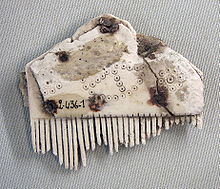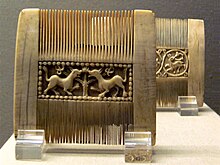Leg crest
As leg comb one will comb refers to the bone, ivory or antler is.
Most combs from archaeological finds are leg combs . The summarizing term is used sensibly, especially when an exact material determination is not possible or not yet available. Metal combs are much rarer. Wooden combs are also occasionally passed down, but wood decomposes more easily than the materials used for leg combs.
They are particularly numerous in tombs from the Roman Empire and the Merovingian Period , the shapes allow further statements. Thus, late antique combs derived with a triangular or semi-circular handle plate of Germanic forms. The three-layer combs of the Imperial and Merovingian periods are among the chronologically sensitive forms that can help date a burial.
literature
- HW Böhme, Germanic grave finds from the 4th – 5th centuries Century between the lower Elbe and Loire. Studies on chronology and population history. Munich contribution. Mornings 9 (Munich 1974). P. 122 ff.
- S. Thomas: Studies on the Germanic ridges of the Roman Empire . Work and research reports on the maintenance of the Saxon soil monuments, Volume 8. Dresden 1960. pp. 54–115.

